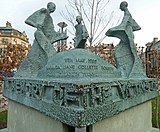Bradford City stadium fire
 |
|
| Date | 11 May 1985 |
|---|---|
| Location |
Valley Parade Bradford, West Yorkshire |
| Coordinates | 53°48′15″N 001°45′32″W / 53.80417°N 1.75889°WCoordinates: 53°48′15″N 001°45′32″W / 53.80417°N 1.75889°W |
| Deaths | 56 |
| Non-fatal injuries | 265 |
| Inquiries | Popplewell Inquiry |
| Coroner | James Turnbull |
| Website | www |
The Bradford City stadium fire was a stadium disaster that occurred during an English League Third Division fixture between Bradford City and Lincoln City on Saturday, 11 May 1985, killing 56 and injuring at least 265.
The Valley Parade stadium, long-established home to Bradford City Football Club, had been noted for its antiquated design and facilities, including the wooden roof of the main stand. Warnings had also been given about a major build-up of litter just below the seats. The stand had been officially condemned and was due for demolition.
The match against Lincoln City had started in a celebratory atmosphere, with the home-team receiving the Football League Third Division trophy. At 3.40 pm, a small fire was reported by TV commentator John Helm, but in less than four minutes, in windy conditions, it had engulfed the whole stand, trapping some people in their seats. In the panic that ensued, fleeing crowds had to break down locked exits to escape, and many were burnt to death at the turnstiles, which were also locked. There were many cases of heroism, with more than fifty people receiving police awards or commendations.
The disaster led to new safety standards in UK football grounds, including the banning of new wooden grandstands.
Bradford City continues to support the Burns Unit at Bradford Royal Infirmary as its official charity.
Bradford City Association Football Club had played their home games at Valley Parade, in Bradford, since the club was formed in 1903. It had been the former home of Manningham Rugby Football Club, which had moved into the ground in 1886. The playing area and stands were very basic but the ground had enough room for 18,000 spectators. When the association football club was formed, the ground was changed very little and had no covered accommodation. However, when Bradford City won promotion to the highest level of English football, Division One, in 1908, club officials sanctioned an upgrade programme. Football architect Archibald Leitch was commissioned to carry out the work. By 1911, his work was completed. It included a main stand which seated 5,300 fans, and had room for a further 7,000 standing spectators in the paddock in front. The main stand was described as a "mammoth structure", but was unusual for its time because of its place on the side of a hill. The entrances to the stand were all at the rear and were higher than the rest of the ground.
...
Wikipedia
